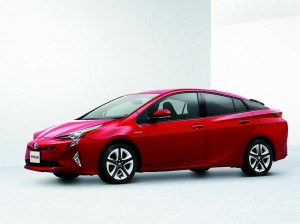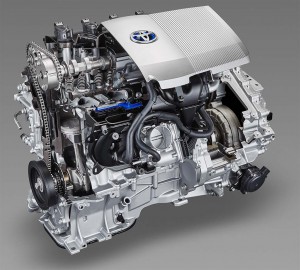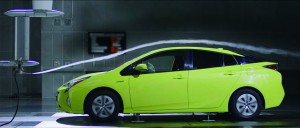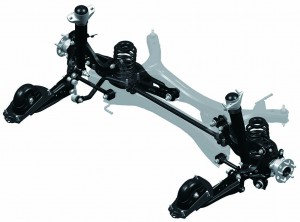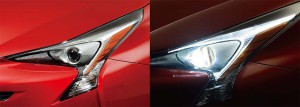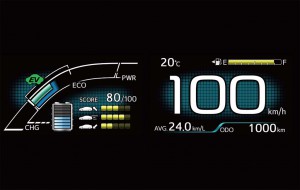Five weeks after unveiling the 2016 Toyota Prius at a splashy Las Vegas event, the Japanese maker is finally filling in some of the critical details about the new hybrid-electric vehicle.
Among other things, Toyota claims the drivetrain on the 2016 Prius is significantly more efficient than the outgoing model. And buyers will not have a choice of either conventional nickel-metal hydride batteries or a more advanced lithium-ion pack. Improved aerodynamics and weight-saving measures are expected to deliver as much as 10% fuel economy.
Toyota also is offering a bit closer look at the structure of the 2016 Prius, including details of its new independent rear suspension which is intended to improve the ride and handling of the fourth-generation hatchback.
While Toyota retains the 1.8-liter displacement of the old model’s internal combustion engine, it claims the four-cylinder powerplant has been “completely re-engineed with remarkable results in terms of performance, fuel economy and reductions to size and weight.”
Thermal efficiency reaches 40%, according to a Toyota release, well above that of conventional IC engines. The maker credits such things as a large-volume exhaust gas recirculation system and improved combustion efficiency. The air intake has been reworked, as has the coolant system. And powertrain engineers put a major emphasis on reducing friction throughout the engine.
The rest of the familiar Hybrid Synergy Drive system have been updated, albeit retaining the same basic layout Toyota has used since the first of its gas-electric models went on sale nearly two decades ago.
The transaxle and motor are lighter and more compact, and Toyota claims a 20% reduction in mechanical losses due to reduced friction. The power control unit also has been updated to reduce losses by about 20%.
In an unusual move, Toyota will finally offer a lithium-ion battery pack that is expected to offer more electric-only range, though few details have yet been released. The LIon pack is expected to carry a premium over a more conventional nickel-metal hydride battery unit.
(Toyota set to debut 3 concept cars – and a painfully cute robot – at Tokyo Motor Show. Click Here for more.)
A few key details still have yet to be disclosed, among other things what the final mileage of the 2016 Toyota Prius will be. The outgoing model achieved 51 mpg City and 48 Highway – hybrids routinely doing better in stop-and-go conditions that allow their batteries to recharge. If the new hatchback makes its target, it would likely deliver something north of 55 mpg around town.
To get there, Toyota has made other changes to the 2016 Prius, including the use of new active grille shutters that reduce aerodynamic losses and help the IC engine operate within its most efficient temperature range.
The overall body has been redesigned, adopting some of the changes we’ve seen on other recent models from Toyota – and reflecting the maker’s push to add more “passion” to its styling. That new look has generated a fair bit of controversy, however, especially with the 2016 hybrid’s low-slung nose – which has dropped almost three inches — featuring a new twin-beam LED headlight system.
Overall, the 2016 Prius is 2.4 inches longer, 0.6 inches wider, and about an inch lower than the outgoing model.
The active grille shutters and a smoother underbody help achieve an extremely low 0.24 coefficient of drag.
The rear of the 2016 Toyota Prius features new wrap-around LED lights and an integrated spoiler.
(Click Here for a review of the new 2016 Chevrolet Volt.)
Inside, Toyota has attempted to spruce up what has traditionally been a rather Spartan cabin. There are more soft-touch points, nicer materials, and more comfortable seats. One of the odder choices, however, brings the use of a white iPhone-like plastic to portions of the center console and stack. That’s all the more surprising since Chevrolet abandoned the use of similar material on the original Volt due to poor reviews and customer feedback.
The new Prius instrument panel is more sculpted, with revised and repositioned gauges, controls and displays. There are now twin 4.2-inch multi-information display screens, and the new Prius will add a number of new high-tech features, including the Toyota Safety Sense P package. That includes blind-spot warning, active cruise control and, among other things, forward collision warning with pedestrian protection.
The latest Toyota release suggests the 2016 Prius will deliver improved performance, but how much is unclear. It’s likely to focus mostly on 0 to 30 launch, rather than any real breakthrough in the old model’s unremarkable 0 to 60 times, several Toyota insiders have hinted.
Where buyers should be more pleased is in the overall ride and handling, the new model finally adopting a modern independent double-wishbone rear suspension for the first time.
Pricing is one of the remaining details Toyota needs to fill in. The current 2015 Toyota Prius starts at $24,200.
Along with the standard hatchback, look for Toyota to follow up with a second-generation plug-in hybrid version next year.
(Toyota’s Scion brand teases what could be its 1st-ever CUV. Click Here for the story.)

